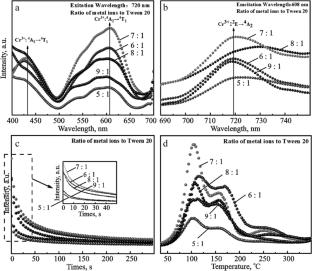Effect of Metal Ions Ratio on Luminescence Properties of LiGa5O8:Cr3+
Abstract
Near-infrared long afterglow materials have the characteristics of non-obscuring bio autofluorescence and good photo/chemical stability. They can play an essential role in bioimaging, whereas LiGa5O8:Cr3+ has long afterglow and optical photoexcitation properties. In this paper, LiGa5O8:Cr3+ nanophosphors were successfully synthesized by hydrothermal method. X-ray diffraction (XRD) patterns were recorded using an X-ray diffractometer. Luminescence spectra and decay curves were obtained via a fluorescence spectrophotometer. The microstructural properties of the samples were analyzed using scanning electron microscopy (SEM). Transmission electron microscopy (TEM) images were recorded on a TEM instrument. Thermoluminescence spectrometer was employed to obtain a thermoluminescence curve. Using Tween 20 as the experimental chelating agent, it was found that the ratio of total metal ions to Tween 20 significantly affected the luminescence properties of LiGa5O8:Cr3+. When the ratio of total metal ions to Tween 20 was 7 : 1, the sample had less impurity phase, high crystallinity, regular grain shape, and a size of about 100 nm. The fluorescence spectra showed that the main excitation peaks were 410 nm and 608 nm, and the main emission peaks were 720 nm. The sample with a ratio of 7 : 1 had a higher relative intensity than all other samples, with more effective traps and greater stored energy to produce more luminescent carriers. The kinetic order at this point was 2. It provides a solid basis for bioimaging.


 求助内容:
求助内容: 应助结果提醒方式:
应助结果提醒方式:


